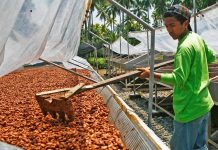Instead of giving preference to foreign species of flora and fauna to students, schools must focus on educating school children with species of flora and fauna that are endemic in the Philippines.

This was the call made by young scientists from the University of Mindanao – Milton Medina and Analyn Cabras who presented their latest discoveries of new endemic species of flora and fauna during the regular Habi at Kape press conference at the Abreeza Mall in Davao City on Wednesday, March 8.
Both researchers also called on the Department of Environment and Natural Resources to establish critical habitats and protected areas for endemic species in the country especially those considered endangered.
Moisture, they added, are part of the ecosystem and biodiversity that support endemic flora and fauna species in the country.
Destruction of forests will destroy the ecosystem that will endanger these endemic species and eventually cause for their extinction, the researchers added.
Researcher Analyn Cabras presented to the media a new species of Pachyrhynchus that belong to a hyper diverse family of beetles called weevils.
The new species, Pachyrhynchus miltoni, were found in the hinterlands of Marilog District in Davao City.
“The new discovered species was named after young researcher Milton Medina who obtained the material for identification from Barangay Baganihan, Marilog District,” Cabras said.
Pachyrhynchus miltoni, she added, is closely related to Pachyrhynchus speciosus samarensis and P. Kraslavae but differs on the shape of aedeagus (male genitals) and features of the coloration of the body.
Cabras said there are approximately 51,000 species of weevils under 4,600 genera in the world – and in the Philippines, one of the most conspicuous weevils are members of the genus Pachyrhynchus.
Medina, on the other hand, presented the new species Hoya (Apocynaceae) that was found in Valencia City, Bukidnon province.
“Recently, new species was added to the Genus Hoya in the Philippines and named Hoya reyesii in honor to Dr. Ricardo Reyes, a plant grower and hobbyist who collected the plant sometime in 2014,” Medina said.
Dr. Reyes personally handed the plant species to Medina for detailed examination.
The examination, that runs for two to three months, include the description of both the vegetative and reproductive characters using stereomicroscope procedures in accordance with the rules of International Code for Botanical Nomenclature (ICBN), Medina said.
The newly-discovered species was closely associated with Hoya amorosoae species that can be found in Mt. Hamiguitan in Davao Oriental, he added.
“The size of the flower is as small as the head of the common matchstick hence making the species as one of the smallest in the section of Acanthostemma,” Medina described.
He said the morphological descriptions of the new species were validated and confirmed by Robert Dale Kloppenburg in Fresno, California, USA.
Kloppenburg is a world leading expert in Hoya.
Both scientists said they are now on review and inventory of fauna and flora species that are endemic in the country.
The result of the inventory will be transformed into reading and learning materials that can be used in schools to help educate school children learn on the countries endemic species.






